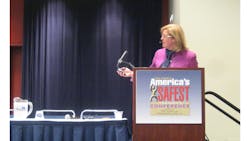Safety’s Impact on Corporate Sustainability and Social Responsibility
When Seabrook asked conference attendees if they held responsibilities related to sustainability in addition to their health and safety duties, hands rose across the room.
“This is a trend,” she said, adding that had she asked that same question 3 years ago, fewer hands would have gone up. “Things are changing. Safety and health are [now] part of sustainability.”
That trend is here to stay, she added, as is reflected in the business landscape. In 2010, 95 percent of Fortune 250 companies recognized and released corporate social responsibility reporting. Furthermore, 80 percent of these companies used Global Reporting Initiative (GRI) sustainability framework guidelines.
With more companies using GRI guidelines, and with the fourth version of the guidelines expected to be released in 2013, Seabrook stressed the importance of reshaping and improving the safety requirements. Right now, she explained, the safety component of the G3 guidelines focuses largely on lagging indicators, and ideally should be updated to include more leading safety indicators.
Seabrook also addressed the fact that more and more consumers are looking for sustainable, green products, which is significant because 70 percent of the market is driven by general consumers. Additionally, she pointed out that the “Wal-Mart Effect” has “has almost single-handedly forced sustainability around the world” to provide those sustainable products to customers.
But no matter what business a particular organization may be in, sustainability must be integrated with safety and health.
“We need to align safety and health with [the organization’s] business strategy. We are business enablers,” Seabrook told ASC attendees. “We are integrated, part of every aspect of the organization ... At the end of the day, it’s all about connectivity.”
About the Author

Laura Walter
Laura Walter was formerly senior editor of EHS Today. She is a subject matter expert in EHS compliance and government issues and has covered a variety of topics relating to occupational safety and health. Her writing has earned awards from the American Society of Business Publication Editors (ASBPE), the Trade Association Business Publications International (TABPI) and APEX Awards for Publication Excellence. Her debut novel, Body of Stars (Dutton) was published in 2021.

